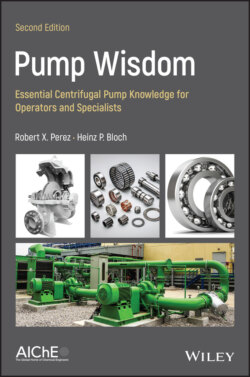Читать книгу Pump Wisdom - Robert X. Perez - Страница 15
The Meaning of Specific Speed
ОглавлениеPump impeller flow classifications and the general meaning of specific speed deserve further discussion. Moving from left to right in Figure 1.5, the various impeller geometries reflect selections that start with high differential pressure capabilities and end with progressively lower differential pressure capabilities. Differential pressure is simply discharge pressure minus suction pressure.
Specific speed calculations are a function of several impeller parameters; the mathematical expression includes exponents and is found later, in Figure 1.6. Staying with Figure 1.5 and again moving from left to right, we can reason that larger throughputs (flows) are more likely achieved by the configurations at right, whereas larger pressure ratios (discharge pressure divided by suction pressure) are usually achieved by the impeller geometries closer to the left of the illustration.
Impellers toward the right are more efficient than those near the left, and pump designers use the parameter specific speed (N s) to bracket pump hydraulic efficiency attainment and other expected attributes of a particular impeller configurations and size. Please be sure not to confuse a very similar sounding parameter, pump suction specific speed (N ss or N sss), with the specific speed (N s). For now, we are strictly addressing specific speed (N s).
As an example, observe the customary use, whereby with N and Q – the typical given parameters that define centrifugal process pumps – one determines a pivot point. Next, with pivot point and head H, one can easily determine N s. In Figure 1.5, Ns is somewhere between 500 and 15 000 on the US scale. Whenever we find ourselves in that range, we know such a pump exists, and we can even observe the general impeller shape. Keep in mind that thousands of impeller combinations and geometries exist. Impellers with covers are the most prominent in hydrocarbon processes, and an uneven number of impeller vanes is favored over even numbers of vanes for reasons of vibration suppression.
Pump specific speed, Figure 1.6, might be of primary interest to pump designers, but average users will also find it useful. On the lower right, the illustration gives the equation for N s; it will be easy to see how N s is related to the shaft speed N (rpm), flow Q (gpm or gallons/minute), and head H (expressed in feet). This mathematical expression also has two strange‐looking exponents in it, but the N s nomogram conveys more than meets the eye and can be quite helpful.
If now, we had the same or some other Q and would want to see what happens at some other speed, we would again draw a straight line to establish the pivot point. Drawing a line from whatever H is specified through the pivot point and to N s we would not like to select pumps with an N s outside the rule‐of‐thumb range from 500 to 15 000. In another example, we might, after establishing the pivot point, wish to determine what happens if we select an impeller with the maximum head capability of 700 ft and draw a line through the pivot point. If the resulting N s is too low, we would try a higher speed N and see what happens.
Figure 1.6 Pump specific speed nomogram allowing quick estimations. Shown in this illustration is a hypothetical pump application with a flow of 100 gpm operating at 3600 rpm (line 1). To develop 150 ft of head with a single stage, an impeller with a specific speed of 850 (line 2) would be required.
While there are always fringe applications in terms of size and flow rate, this book deals with centrifugal pumps in process plants. These pumps are related to the generic illustrations of Figures 1.1 and 1.2 and others in this chapter. All would somewhat typically – but by no means exclusively – range from 3 to perhaps 300 hp (2–225 kW).
